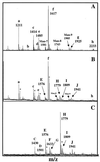Galactose-extended glycans of antibodies produced by transgenic plants
- PMID: 11226338
- PMCID: PMC30237
- DOI: 10.1073/pnas.031419998
Galactose-extended glycans of antibodies produced by transgenic plants
Abstract
Plant-specific N-glycosylation can represent an important limitation for the use of recombinant glycoproteins of mammalian origin produced by transgenic plants. Comparison of plant and mammalian N-glycan biosynthesis indicates that beta1,4-galactosyltransferase is the most important enzyme that is missing for conversion of typical plant N-glycans into mammalian-like N-glycans. Here, the stable expression of human beta1,4-galactosyltransferase in tobacco plants is described. Proteins isolated from transgenic tobacco plants expressing the mammalian enzyme bear N-glycans, of which about 15% exhibit terminal beta1,4-galactose residues in addition to the specific plant N-glycan epitopes. The results indicate that the human enzyme is fully functional and localizes correctly in the Golgi apparatus. Despite the fact that through the modified glycosylation machinery numerous proteins have acquired unusual N-glycans with terminal beta1,4-galactose residues, no obvious changes in the physiology of the transgenic plants are observed, and the feature is inheritable. The crossing of a tobacco plant expressing human beta1,4-galactosyltransferase with a plant expressing the heavy and light chains of a mouse antibody results in the expression of a plantibody that exhibits partially galactosylated N-glycans (30%), which is approximately as abundant as when the same antibody is produced by hybridoma cells. These results are a major step in the in planta engineering of the N-glycosylation of recombinant antibodies.
Figures




References
-
- Miele L. Trends Biotechnol. 1997;15:45–50. - PubMed
-
- Hood E E, Jilka J M. Curr Opin Biotechnol. 1999;10:382–386. - PubMed
-
- Jenkins N, Parekh R B, James D C. Nat Biotechnol. 1996;14:975–981. - PubMed
-
- Lerouge P, Cabanes-Macheteau M, Rayon C, Fischette-Lainé A C, Gomord V, Faye L. Plant Mol Biol. 1998;38:31–48. - PubMed
-
- van Ree R, Cabanes-Macheteau M, Akkerdaas J, Milazzo J-P, Loutelier-Bourhis C, Rayon C, Villalba M, Koppelman S, Aalberse R, Rodriguez, et al. J Biol Chem. 2000;275:11451–11458. - PubMed
Publication types
MeSH terms
Substances
LinkOut - more resources
Full Text Sources
Other Literature Sources

